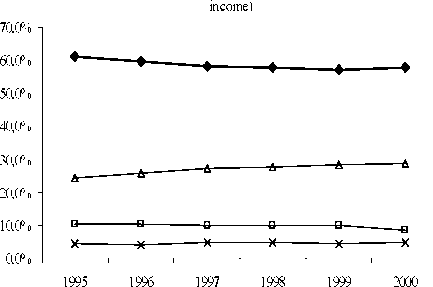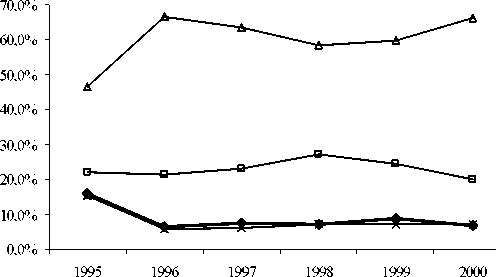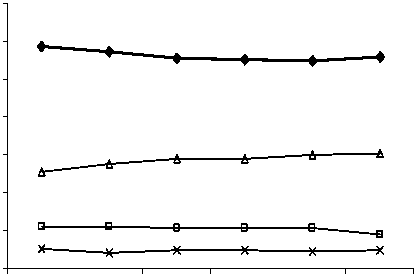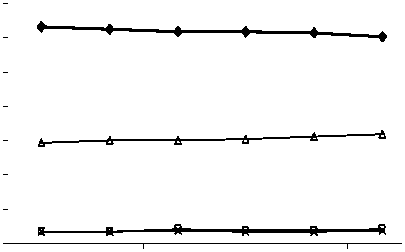Figure 1. Distribution of incomes (receipts) and outlays (expenditures) among Portuguese Institutions from 1995 to 2000
Capital Receipts
(capitaltransfers, within the economy and fromthe rest ofthe
world = investment funds - saving - net lending/borrowing)
Total Receipts
Current Receipts
(compens ation of factors + net indirect taxes + current trans fers,
withinthe economy and from the rest of the world = aggregate


70,0%
60,0%
50,0%
40,0%
30,0%
20,0%
10,0%
0,0%

1995 1996 1997 1998 1999 2000
Current Expenditure
(final consumption + current transfers, within the economy and to
the rest ofthe world = aggregate income - saving)
70,0%
60,0%
50,0%
40,0%
30,0%
20,0%
10,0%
0,0%

50,0% -
40,0% -
30,0% -
20,0% -
10,0% -
0,0% -■
1995
1996
1999
2000
1997 1998


1995 1996 1997 1998 1999 2000
% -
|
% - % - |
Δ--- |
--∆— |
----∆----- _____□ |
—∆- —B- |
------∆--- ----в-— |
----∆ ----в |
|
% - |
□---- χ___ |
-в— | ||||
|
--X— |
----X----- |
—X— |
------X--- |
----X | ||
|
10/ | ||||||
|
∣% |
I |
I | ||||
|
1995 |
1996 |
1997 |
1998 |
1999 |
2000 | |
|
—♦—Households — |
!—Enterprises |
Government -3 |
<— Others | |||
Capital Expenditure
(gross capital formation + capital transfers, within the economy and
to the rest of the world = investment)
60,0% -∣
Total Expenditure
% -I
Source: Portuguese SAMs (Appendixes)
More intriguing information
1. An Incentive System for Salmonella Control in the Pork Supply Chain2. The effect of classroom diversity on tolerance and participation in England, Sweden and Germany
3. The name is absent
4. Optimal Taxation of Capital Income in Models with Endogenous Fertility
5. AGRIBUSINESS EXECUTIVE EDUCATION AND KNOWLEDGE EXCHANGE: NEW MECHANISMS OF KNOWLEDGE MANAGEMENT INVOLVING THE UNIVERSITY, PRIVATE FIRM STAKEHOLDERS AND PUBLIC SECTOR
6. The name is absent
7. The name is absent
8. The Evolution
9. La mobilité de la main-d'œuvre en Europe : le rôle des caractéristiques individuelles et de l'hétérogénéité entre pays
10. Investment and Interest Rate Policy in the Open Economy